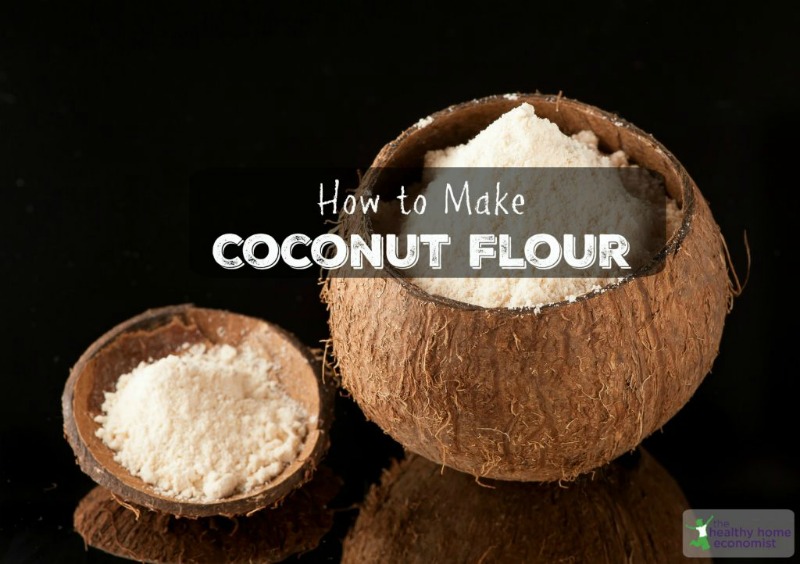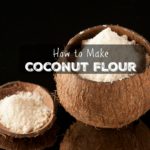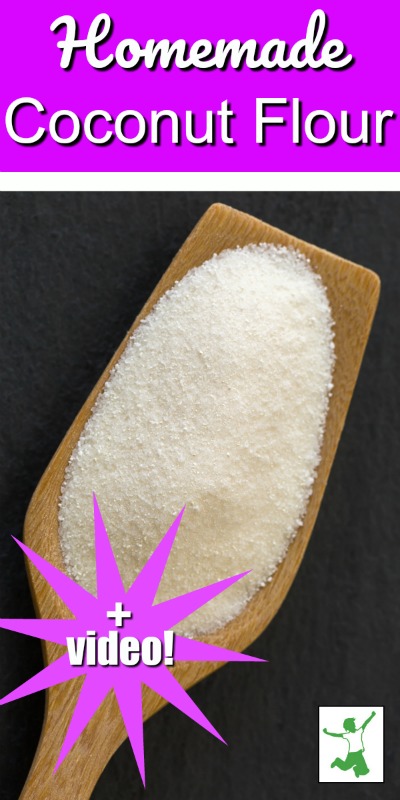Table of Contents[Hide][Show]
Easy recipe plus video tutorial for homemade coconut flour which is a simple, budget-friendly, low carb, and gluten-free alternative to expensive store-bought brands. Lasts for months!
More and more people are turning to store-bought or homemade coconut flour these days. It is a delicious low carb and Keto-friendly alternative to grain-based flours.
Coconut flour is a disaccharide free food. As such, it is an acceptable flour for baking when following the GAPS, AIP or SCD healing diet.
In addition, coconut flour is Paleo and Primal friendly for those who avoid grains.
The primary problem with coconut flour is that it is rather expensive to buy. As a result, many folks are learning to make it themselves, which is incredibly budget-friendly.
Today’s video plus written coconut flour recipe expands on articles and video tutorials which showed you how to make homemade coconut milk and coconut milk kefir.
Recipes Using Homemade Coconut Flour
Learning how to make homemade coconut flour is extremely easy to do and worth the effort. Buying it at the store is pricey. A small one-pound bag at my health food store costs about $6. You can go through one of these quickly if you use it a lot.
Homemade coconut flour can be used in loads of baking recipes. Popular recipes using coconut flour on this blog include:
If you are simply avoiding gluten but eat grains, this tutorial plus recipe on homemade gluten-free flour may prove helpful.
Note that you cannot substitute coconut flour for grain-based flours 1:1. Coconut flour behaves very differently when baking than grain-based flour does. It also requires more eggs. Hence, you need a specific recipe that uses coconut flour for whatever baked good you wish to make.
Remember that using soaked coconut flour is best if you are sensitive to phytates and lectins. While coconut flour is not excessively high in these anti-nutrients, it is a good idea to soak it if you eat it often.
How to Make Coconut Flour Tutorial
The video tutorial included with the recipe below provides easy instructions on how to make coconut flour yourself without the inconvenience of having to open a coconut first!

Homemade Coconut Flour Recipe
Easy recipe for homemade coconut flour which is a simple, budget friendly, and gluten free alternative to expensive store bought brands.
Ingredients
- 1 cup desiccated coconut or leftover coconut fiber from making coconut milk
- 1 food processor or blender
Instructions
-
If using leftover coconut fiber from making homemade coconut milk, spread out coconut fiber on a cookie sheet and dry in a warm 200 F/ 93 C oven overnight.
-
Place coconut fiber or desiccated coconut in food processor or blender. Blend on high for a minute or two until the coconut fiber or desiccated coconut is finely ground into coconut flour. You do not need a grain grinder.
-
Refrigerate in a sealed container. It will last for many months.
Recipe Video









Sarah,
Thanks for your video tutorials! I tried to make coconut flour by using one “brown”/old coconut and 1 young coconut. I was also planning on making the milk first and then drying the pulp for flour. I chopped it all up, included the natural coconut water and put it in my Vitamix. Since I don’t have a juicer I was going to strain it through cheesecloth like you suggested in the video. What happened though was the coconut fat spread all over the side of the Vitamix. Then, when I went to strain it I could tell I was wasting all of the fat as it was gumming up the cheesecloth. What did I do wrong? How do you get the fat out of it first? It was blended up so small that even when I refrigerated it the fat didn’t separate enough to render. The whole mess is now in my freezer awaiting your response! It seems like this might all have happened even if I’d used my food processor instead of my Vitamix. What do you think I did wrong?
I have not tried this myself yet but I use coconut oil all the time. I’m guessing the temperature of the room you were working in was probably too cold bc coconut oil solidifies at room temp. I’ve had it gum up for different projects/recipes for the same reason… especially in the blender. Make sure everything is at least 75 degrees.
Then again it could be that the temp should stay cooler the whole time. In any case it sounds like it was warm enough for the oils to liquefy and then cooled down & stuck together.
Thanks so much for this information. We have lots of coconuts around, but coconut flour is not available. With this ingredient, I can eat bread again. Stay healthy!
I have a microwave, too. I use socks filled with cheap white rice and I microwave them for hot pads and I use the microwave to kill germs in the kitchen sponges. I use the vent fan on it as it is installed over the stove but I feel kind of bad about it being there. I had never thought about it as a storage space! I have a bread box but baking enough bread for my family of 12 means more bread than it can hold. I will just pop it in the microwave when I bake today! And birthday cake? Great idea, I have two birthdays this month. I NEVER thought I would find good uses for a microwave, let alone here!
Hi Sarah,
I was excited to see your post on coconut flour making till I heard you say that you need a juicer to get the fibre. I do not have a juicer. I guess that there is no any other way to make coconut flour is there? Should I buy an inexpensive juicer? I worry that a cheap one would leave quite a bit of the milk in the fibre and that it might burn out.
Is there an option, when leaving a comment, to be notified when new comments appear?
Thank you.
Alina
I bought a “nut bag” for about $10 and I just pour my liquid through that; it strains out all the pulp! 🙂
I recently started using coconut flour in baking and LOVE it…however, I agree the price is high, which is why I had previously steered away from it. This video show how completely easy it is make. Thanks!
Hello Sarah! I really enjoy your videos and am thrilled that I can make coconut flour… always wondered if I could do it, but never made the time to experiment… thanks for doing the work ;o) Also, I would really appreciate if you can write out what you do to make the coconut flour. I am deaf and depend on lip-reading… its not easy to do on video ;oP I tried the CC button that YouTube provides, but it really sucked! LOL! Thanks!!
Thanks, Sarah! I *love* how you show how SIMPLE all this is. THANK YOU.
~KristenM
(AKA FoodRenegade)
Hi Sarah, thanks for another great video! I was wondering if one could make coconut flour out of organic, unsweetened coconut flakes that you buy at the health food store?
Hi Sara, you would need to make coconut milk with the coconut flakes first to get the fat out of it and then make coconut flour with the remaining, dried pulp. Otherwise, the flour would be too greasy with the coconut fat.
Hi Sarah,
I am enjoying your website also….I just got my first two 6 gallon buckets of wheat and spelt for flour making, thanks to you walking us through that. I love the way you explain everything!
My question is about coconut flour. I have tried baking with it before without too good result. I am not certain if I am doing it wrong or just need practice. It seems very eggy and heavy. Do you have any helpful hints?
Also, do you ever use Xylitol for sweetening? What do you know about it…good or bad or both?? Blessings!
Hi Beth, I do not use xylitol as it comes from corn and more than likely – genetically modified corn. It just doesn’t seem to natural to me.
Baked goods made with coconut flour are rather heavy and VERY filling. The trick is to make sure you whip the batter until it is very very smooth to allow the coconut fiber to fully absorb the liquids in the batter.
Hi, I have some xylitol. It says non GMO on the bag. I’ve been hearing that it’s good for your teeth.
Hi Linda, I would suggest trying coconut sugar as a truly natural alternative. It is low glycemic and is full of minerals to nourish the body while satisfying that sweet tooth. I wrote a post on it a couple months back:
https://www.thehealthyhomeeconomist.com/2011/01/a-healthy-alternative-to-agave/
I will look for it. I would like to try it.
First, I just want to thank you for posting your videos; as I am new to the Nourishing Traditions way of life, your videos are so helpful to be able to see what to do and have someone talk me through each step. Also, thanks for posting them for free!, as I am on a tight budget.
This question is a little off subject, but I am trying to glean as much information as I can. I noticed a microwave in your kitchen, (since I was about to try to sell mine, and thought maybe I shouldn’t if there are any good uses for it), I thought I might ask you first, if it is worth keeping. Thanks.
Hi Bess, I don’t use a microwave for cooking anymore and haven’t for some years now, but it a GREAT place to put birthday cakes and other baked goods to keep them fresh without refrigerating! I use it for this purpose all the time! 🙂
So glad you are finding the videos helpful.
Wow! I never thought of that.
I use my microwave for storage also!